Groundwater Hydrochemistry and Recharge Process Impacted by Human Activities in an Oasis–Desert in Central Asia
Abstract
:1. Introduction
2. Materials and Methods
2.1. Study Area
2.2. Data Collection
2.3. End-Member Mixing Analysis Method
2.4. Statistical Analysis
3. Results
3.1. Variations of Climate, Vegetation and Land Cover
3.2. Stable Water Isotopes
3.3. Dissolved Ions
3.4. Groundwater Level
4. Discussion
4.1. Influence of Human Activities on Groundwater Hydrochemistry
4.2. Groundwater Recharge Sources and Recharge Process
5. Conclusions
- (i)
- During 2000 to 2020, the NDVI and cultivated land area both exhibited a significant increasing trend, while the variation trend of air temperature and precipitation was not obvious, indicating the important effect of cultivated land area increase on vegetation cover.
- (ii)
- Stable water isotopes and dissolved ions of groundwater and surface water exhibited obviously spatial heterogeneity and seasonal variation. Except for HCO3−, the spatial distribution pattern of major dissolved ions for shallow groundwater was consistent, increasing along the groundwater flow direction from midstream to downstream. Surface water and groundwater were both characterized by higher δ18O and TDS in the non-flood season than those in the flood season, due to the massive recharge from runoff in the flood season. The seasonal variation in δ18O and TDS was the largest in shallow groundwater, followed by surface water and middle groundwater.
- (iii)
- DGL showed obvious spatio-temporal variation, and differed obviously among the monitoring wells. Except for the D5 well, the groundwater level in the monitored wells presented a decreasing trend from 2018 to 2021, accompanied by a decrease in TDS in phreatic aquifer. The NDVI in the desert area generally decreased with the decrease in groundwater level. Generally, the greater the groundwater level decrease in the desert area, the greater the NDVI decrease.
- (iv)
- Gypsum dissolution and weathering of silicate and halite had an important role in forming groundwater hydrochemistry in the region. Human activities significantly affected the hydrochemical evolution and recharge process of groundwater in the plain of the Dina River Basin. Shallow groundwater was mainly recharged by surface water and lateral groundwater flow, accounting for 73% and 27%, respectively, indicating the dominant role of local surface water. Agricultural activities and groundwater overexploitation were the main factors for the variations in the groundwater level and quality in the oasis area, which could directly affect groundwater and natural vegetation in the desert area. Hence, attention should be paid to the importance of the effect of anthropogenic activities on groundwater level and quality in the efficient utilization of groundwater resources.
Author Contributions
Funding
Data Availability Statement
Acknowledgments
Conflicts of Interest
References
- Lezzaik, K.; Milewski, A.; Mullen, J. The groundwater risk index: Development and application in the Middle East and North Africa region. Sci. Total Environ. 2018, 628, 1149–1164. [Google Scholar] [CrossRef] [PubMed]
- Jasechko, S.; Seybold, H.; Perrone, D.; Fan, Y.; Kirchner, J.W. Widespread potential loss of streamflow into underlying aquifers across the USA. Nature 2021, 591, 391–395. [Google Scholar] [CrossRef] [PubMed]
- Zhang, J.; Jing, H.H.; Dong, K.B.; Jin, Z.X.; Ma, J.Q. The effect of drip irrigation under mulch on groundwater infiltration and recharge in a semi-arid agricultural region in China. Water Supply. 2022, 22, 4043–4054. [Google Scholar] [CrossRef]
- Zhong, Y.; Zhong, M.; Feng, W.; Zhang, Z.; Shen, Y.; Wu, D. Groundwater depletion in the West Liaohe River Basin, China and its implications revealed by GRACE and in situ measurements. Remote Sens. 2018, 10, 493. [Google Scholar] [CrossRef]
- Tonkul, S.; Baba, A.; Şimşek, C.; Durukan, S.; Demirkesen, A.C.; Tayfur, G. Groundwater recharge estimation using HYDRUS 1D model in Alaşehir sub-basin of Gediz Basin in Turkey. Environ. Monit. Assess. 2019, 191, 610. [Google Scholar] [CrossRef] [PubMed]
- Khmila, K.; Trabelsi, R.; Zouari, K.; Kumar, U.S. Application of geochemical and isotopic tracers for the evaluation of groundwater quality in the irrigated area of the Sbiba plain (Central West Tunisia). Agric. Ecosyst. Environ. 2021, 313, 107298. [Google Scholar] [CrossRef]
- Rehman, N.; Ali, W.; Muhammad, S.; Tepe, Y. Evaluation of drinking and irrigation water quality, and potential risks indices in the Dera Ismail Khan district, Pakistan. Kuwait J. Sci. 2024, 51, 100150. [Google Scholar] [CrossRef]
- Mao, W.; Zhu, Y.; Wu, J.; Ye, M.; Yang, J. Modelling the salt accumulation and leaching processes in arid agricultural areas with a new mass balance model. J. Hydrol. 2020, 591, 125329. [Google Scholar] [CrossRef]
- Han, D.; Currell, M.J.; Cao, G.; Hall, B. Alterations to groundwater recharge due to anthropogenic landscape change. J. Hydrol. 2017, 554, 545–557. [Google Scholar] [CrossRef]
- Feng, S.; Liu, Z.; Han, Y.; Wang, L.; Hu, Z.; Qi, M. Effect of groundwater depression cone on the hydrochemical evolution process in the People’s Victory Canal irrigation area, China. Processes 2022, 10, 2563. [Google Scholar] [CrossRef]
- Wang, W.H.; Chen, Y.N.; Wang, W.R.; Zhu, C.G.; Chen, Y.P.; Liu, X.G.; Zhang, T.J. Water quality and interaction between groundwater and surface water impacted by agricultural activities in an oasis-desert region. J. Hydrol. 2023, 617, 128937. [Google Scholar] [CrossRef]
- Jia, H.; Qian, H.; Zheng, L.; Feng, W.; Wang, H.; Gao, Y. Alterations to groundwater chemistry due to modern water transfer for irrigation over decades. Sci. Total. Environ. 2020, 717, 137170. [Google Scholar] [CrossRef] [PubMed]
- Ullah, A.; Ali, W.; Muhammad, S.; Ijaz, J.; Amir, F.; Iqbal, S. Comprehensive evaluation of hydro-chemical processes, suitability, health risks, and sources of groundwater contamination using compositional data analysis, Nizampur basin, Pakistan. Groundw. Sustain. Dev. 2023, 23, 101021. [Google Scholar] [CrossRef]
- Smerdon, B.D. A synopsis of climate change effects on groundwater recharge. J. Hydrol. 2017, 555, 125–128. [Google Scholar] [CrossRef]
- Sultan, M.; Sturchio, N.C.; Alsefry, S.; Emil, M.K.; Ahmed, M.; Abdelmohsen, K.; AbuAbdullah, M.M.; Yan, E.; Save, H.; Alharbi, T.; et al. Assessment of age, origin, and sustainability of fossil aquifers: A geochemical and remote sensing-based approach. J. Hydrol. 2019, 576, 325–341. [Google Scholar] [CrossRef]
- Su, Z.M.; Wu, J.H.; He, X.D.; Elumalai, V. Temporal changes of groundwater quality within the groundwater depression cone and prediction of confined groundwater salinity using Grey Markov model in Yinchuan area of Northwest China. Expo. Health 2020, 12, 447–468. [Google Scholar] [CrossRef]
- Omar, M.E.D.M.; Moussa, A.M.A.; Hinkelmann, R. Impacts of climate change on water quantity, water salinity, food security, and socioeconomy in Egypt. Water Sci. Eng. 2021, 14, 17–27. [Google Scholar] [CrossRef]
- Singh, A. Groundwater recharge assessment and long-term simulation for managing the threat of salinization of irrigated lands. J. Hydrol. 2022, 609, 127775. [Google Scholar] [CrossRef]
- Pant, R.R.; Zhang, F.; Rehman, F.U.; Wang, G.; Ye, M.; Zeng, C.; Tang, H. Spatiotemporal variations of hydrogeochemistry and its controlling factors in the Gandaki River Basin. Central Himalaya Nepal. Sci. Total Environ. 2018, 622–623, 770–782. [Google Scholar] [CrossRef]
- Cao, T.; Han, D.; Song, X.; Trolle, D. Subsurface hydrological processes and groundwater residence time in a coastal alluvium aquifer: Evidence from environmental tracers (delta 18O, delta 2H, CFCs, 3H) combined with hydrochemistry. Sci. Total Environ. 2020, 743, 140684. [Google Scholar] [CrossRef]
- Guo, X.J.; Wang, W.H.; Wang, J.S.; Wang, W. Hydrochemical characteristics and evolution pattern of groundwater system in Baiyangdian wetland. North Chian Plain. Acta Geol. Sin. 2022, 96, 656–672. [Google Scholar]
- Yang, S.; Chen, K.W.; Zhu, B.W.; Tian, Y.; Zeng, Z.Z.; Liu, M.; Zheng, C.M. How does irrigation alter the water, carbon, and nitrogen budgets in a large endorheic river basin? J. Hydrol. 2022, 613, 128317. [Google Scholar] [CrossRef]
- Sun, H.Y.; Mao, Q.G.; Wei, X.F.; Zhang, H.Q.; Xi, Y.Z. Hydrogeochemical characteristics and formation evolutionary mechanism of the groundwater system in the Hami basin. Geol. China 2018, 45, 1128–1141. [Google Scholar]
- Ahmed, M.; Chen, Y.; Khalil, M.M. Isotopic composition of groundwater resources in arid environments. J. Hydrol. 2022, 609, 127773. [Google Scholar] [CrossRef]
- Zhang, B.J.; Li, Z.X.; Feng, Q.; Zhang, B.T.; Gui, J. A review of isotope ecohydrology in the cold regions of Western China. Sci. Total Environ. 2023, 857, 159438. [Google Scholar]
- Gui, J.; Li, Z.X.; Feng, Q.; Zhang, B.J.; Xue, J.; Gao, W.D.; Li, Y.C.; Liang, P.F.; Nan, F.S. Water resources significance of moisture recycling in the transition zone between Tibetan Plateau and arid region by stable isotope tracing. J. Hydrol. 2022, 605, 127350. [Google Scholar]
- Yang, N.; Wang, G.C. Spatial variation of water stable isotopes of multiple rivers in southeastern Qaidam Basin, northeast Qinghai-Tibetan Plateau: Insights into hydrologic cycle. J. Hydrol. 2024, 628, 130464. [Google Scholar] [CrossRef]
- Tian, L.D.; Cai, Z.Y.; Shao, L.L.; Wang, D.; Liu, F. Review on the study of climatic significance of precipitation isotope in Asian monsoon region. Quat. Sci. 2021, 41, 856–863. (In Chinese) [Google Scholar]
- Wang, W.R.; Chen, Y.N.; Chen, Y.P.; Wang, W.H.; Zhang, T.J.; Qin, J.X. Groundwater dynamic influenced by intense anthropogenic activities in a dried-up river oasis of Central Asia. Hydrol. Res. 2022, 53, 532–546. [Google Scholar] [CrossRef]
- Richards, L.A.; Magnone, D.; Boyce, A.J.; Casanueva-Marenco, M.J.; van Dongen, B.E.; Ballentine, C.J.; Polya, D.A. Delineating sources of groundwater recharge in an arsenic affected Holocene aquifer in Cambodia using stable isotope based mixing models. J. Hydrol. 2018, 557, 321–333. [Google Scholar] [CrossRef]
- Wang, W.; Chen, Y.; Wang, W.; Jiang, J.; Cai, M.; Xu, Y. Evolution characteristics of groundwater and its response to climate and land-cover changes in the oasis of dried-up river in Tarim Basin. J. Hydrol. 2021, 594, 125644. [Google Scholar] [CrossRef]
- Chen, Y.N.; Wubuli, W.M.E.J.; Abula, A.K.R.M.; Cheng, Y.; Chen, Y.P.; Hao, X.M.; Wang, Y. Monitoring and analysis of ecological benefits of water conveyance in the lower reaches of Tarim River in recent 20 years. Arid Land Geogr. 2021, 44, 605–611. (In Chinese) [Google Scholar]
- Zeng, Y.Y.; Zhou, J.L.; Nai, W.H.; Li, L.; Tan, P.F. Hydrogeochemical processes of groundwater formation in the Kashgar River Basin, Xinjiang. Arid Zone Res. 2020, 37, 541–550. (In Chinese) [Google Scholar]
- Wang, W.R.; Chen, Y.P.; Wang, W.H.; Yang, Y.H.; Hou, Y.F.; Zhang, S.; Zhu, Z.Y. Assessing the influences of land use change on groundwater hydrochemistry in an oasis-desert region of central Asia. Water 2022, 14, 651. [Google Scholar] [CrossRef]
- Wang, W.R.; Chen, Y.N.; Wang, W.H.; Chen, Y.P.; Hou, Y.F. Groundwater level dynamic impacted by land-cover change in the desert regions of Tarim Basin, Central Asia. Water 2023, 15, 3601. [Google Scholar] [CrossRef]
- Wang, P.; Yu, J.J.; Zhang, Y.C.; Liu, C.M. Groundwater recharge and hydrogeochemical evolution in the Ejina Basin, northwest China. J. Hydrol. 2013, 476, 72–86. [Google Scholar] [CrossRef]
- Peng, S.; Ding, Y.; Liu, W.; Li, Z. 1 km monthly temperature and precipitation dataset for China from 1901 to 2017. Earth Syst. Sci. Data 2019, 11, 1931–1946. [Google Scholar] [CrossRef]
- Zanaga, D.; Van De Kerchove, R.; Daems, D.; De Keersmaecker, W.; Brockmann, C.; Kirches, G.; Wevers, J.; Cartus, O.; Santoro, M.; Fritz, S.; et al. ESA WorldCover 10 m 2021 v200. 2022. Available online: https://zenodo.org/records/7254221 (accessed on 2 February 2023).
- Sklash, M.G.; Farvolden, R.N. The role of groundwater in storm runoff. J. Hydrol. 1979, 43, 45–65. [Google Scholar] [CrossRef]
- Sen, P.K. Estimates of the regression coefficient based on Kendall’s tau. J. Am. Stat. Assoc. 1968, 63, 1379–1389. [Google Scholar] [CrossRef]
- Yao, J.Q.; Chen, Y.N.; Guan, X.F.; Zhao, Y.; Chen, J.; Mao, W.Y. Recent climate and hydrological changes in a mountain–basin system in Xinjiang, China. Earth-Sci. Rev. 2022, 226, 103957. [Google Scholar] [CrossRef]
- Wang, S.; Zhang, M.; Hughes, C.E.; Zhu, X.; Dong, L.; Ren, Z.; Chen, F. Factors controlling stable isotope composition of precipitation in arid conditions: An observation network in the Tianshan Mountains, central Asia. Tellus B. 2016, 68, 26206. [Google Scholar] [CrossRef]
- Guo, X.Y.; Feng, Q.; Si, J.H.; Xi, H.Y.; Zhao, Y.; Deo, R.C. Partitioning groundwater recharge sources in multiple aquifers system within a desert oasis environment: Implications for water resources management in endorheic basins. J. Hydrol. 2019, 579, 124212. [Google Scholar] [CrossRef]
- Wu, H.W.; Wu, J.L.; Li, J.; Fu, C.S. Spatial variations of hydrochemistry and stable isotopes in mountainous river water from the Central Asian headwaters of the Tajikistan Pamirs. Catena 2020, 193, 104639. [Google Scholar] [CrossRef]
- Barzegar, R.; Asghari Moghaddam, A.; Tziritis, E. Assessing the hydrogeochemistry and water quality of the Aji-Chay River, northwest of Iran. Environ. Earth Sci. 2016, 75, 1486. [Google Scholar] [CrossRef]
- Hale, V.C.; McDonnell, J.J. Effect of bedrock permeability on stream base flow mean transit time scaling relations: 1. A multiscale catchment intercomparison. Water Resour. Res. 2016, 52, 1358–1374. [Google Scholar] [CrossRef]
- Singh, C.K.; Kumar, A.; Shashtri, S.; Kumar, A.; Kumar, P.; Mallick, J. Multivariate statistical analysis and geochemical modeling for geochemical assessment of groundwater of Delhi, India. J. Geochem. Explor. 2017, 175, 59–71. [Google Scholar] [CrossRef]
- Li, P.Y.; Tian, R.; Liu, R. Solute geochemistry and multivariate analysis of water quality in the Guohua Phosphorite Mine, Guizhou Province, China. Expo. Health 2019, 11, 81–94. [Google Scholar] [CrossRef]
- Porhemmat, J.; Nakhaei, M.; Dadgar, M.A. Investigating the effects of irrigation methods on potential groundwater recharge: A case study of semiarid regions in Iran. J. Hydrol. 2018, 565, 455–466. [Google Scholar] [CrossRef]
- Li, W.H.; Zhou, H.H.; Yang, X.M.; Ding, H. Temporal and spatial distribution characteristics of aboveground biomass of grassland plant communities in an arid area. Acta Prataculturae Sin. 2010, 19, 186–195. (In Chinese) [Google Scholar]
- Fang, G.H.; Li, Z.; Yang, J.; Chen, Y.N.; Duan, W.L.; Amory, C.; Wang, Y.Q. Changes in flooding in the alpine catchments of the Tarim River Basin, Central Asia. J. Flood Risk Manag. 2023, 16, e12869. [Google Scholar] [CrossRef]

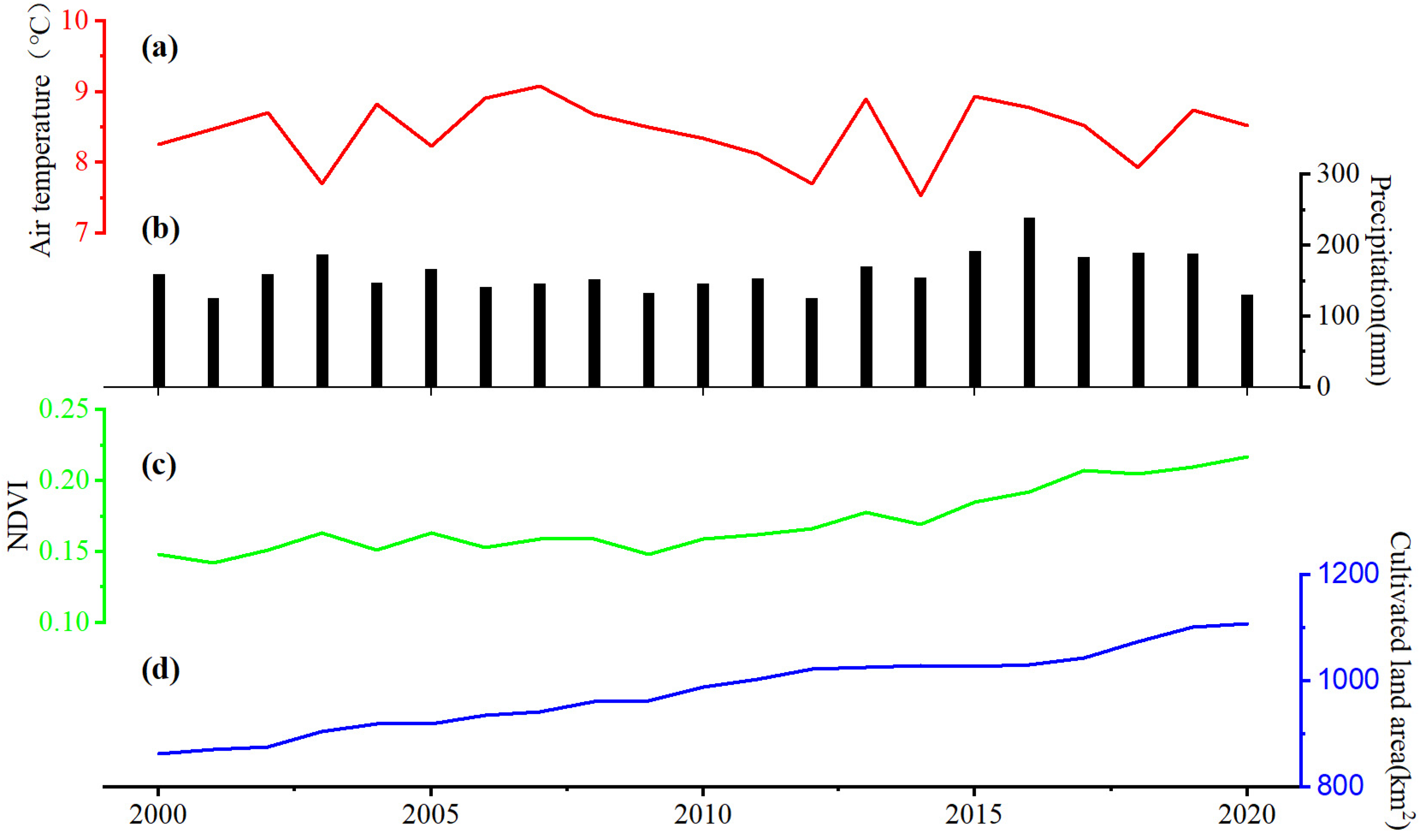

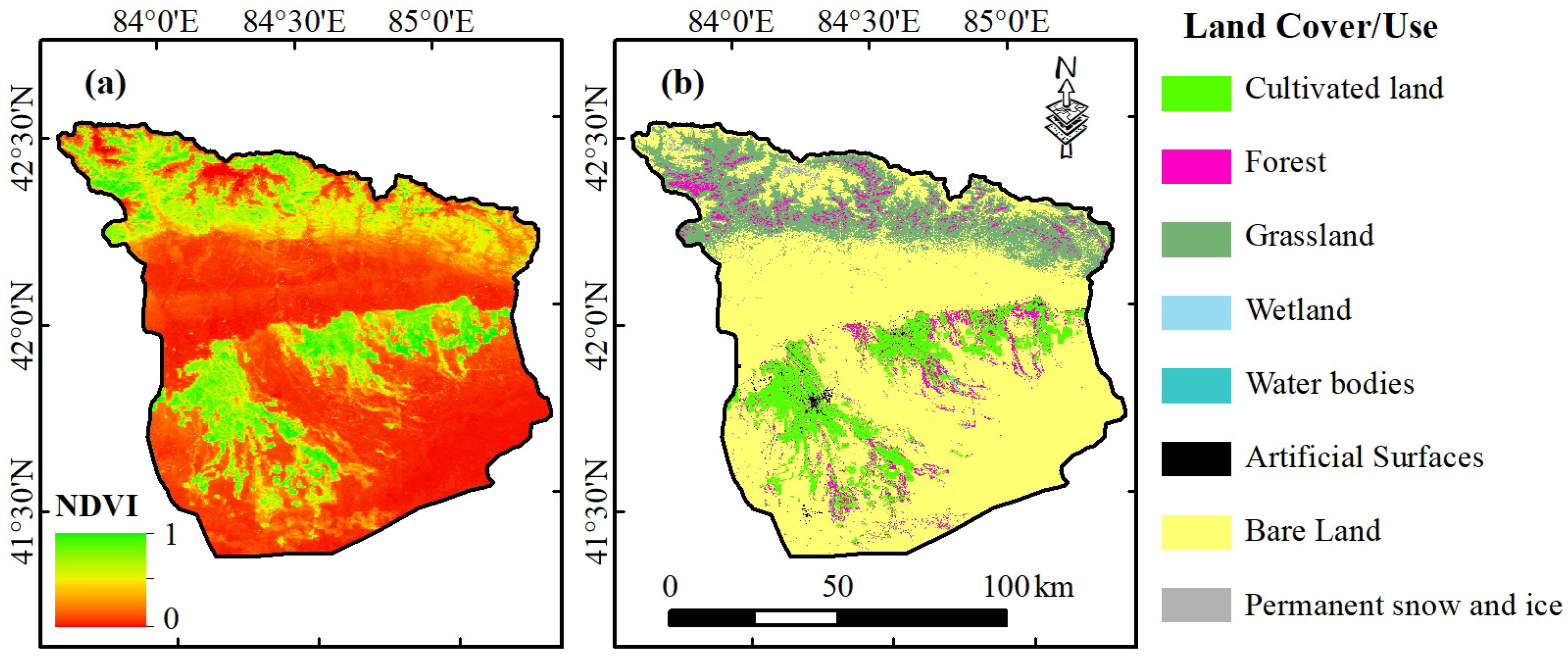
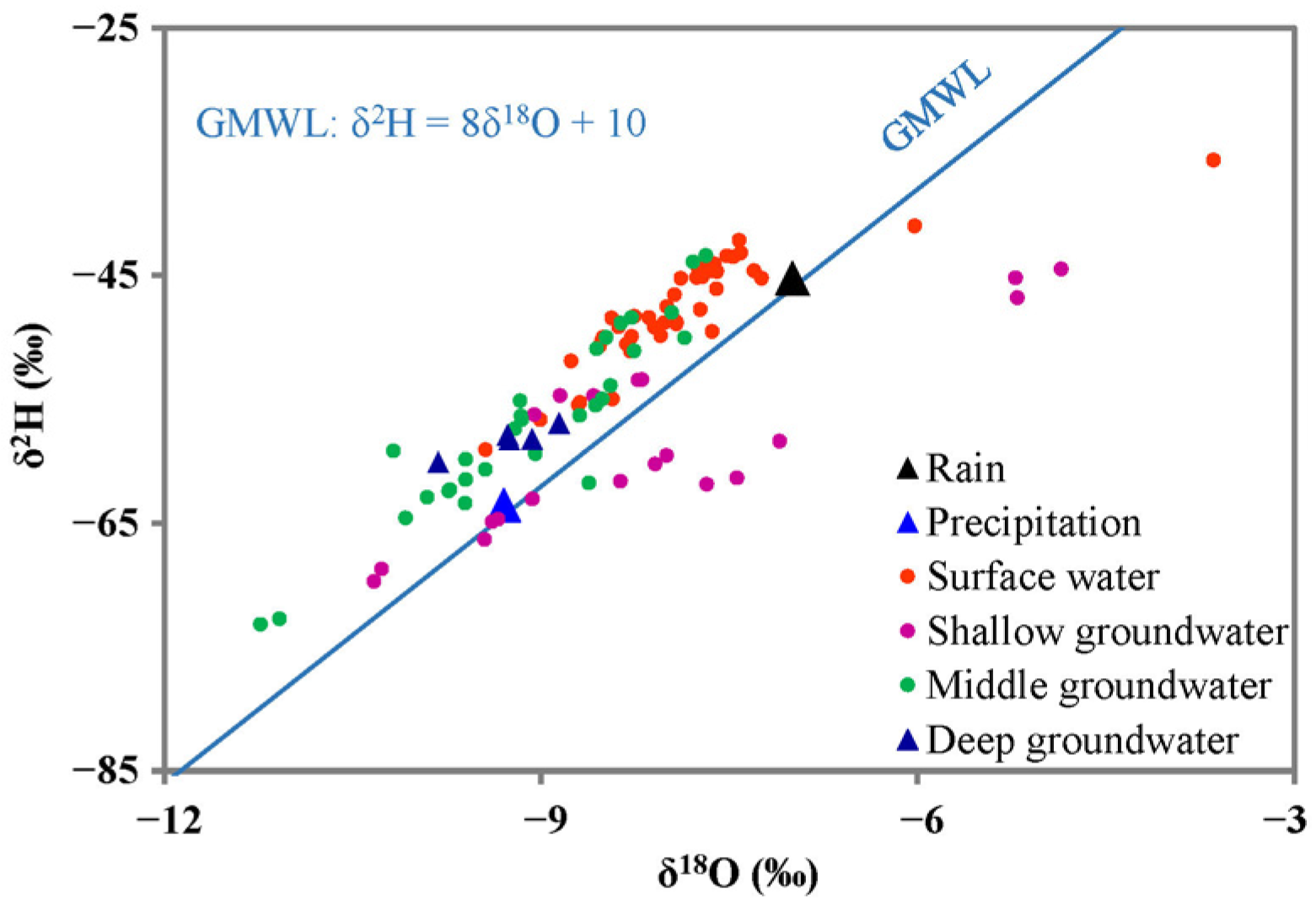

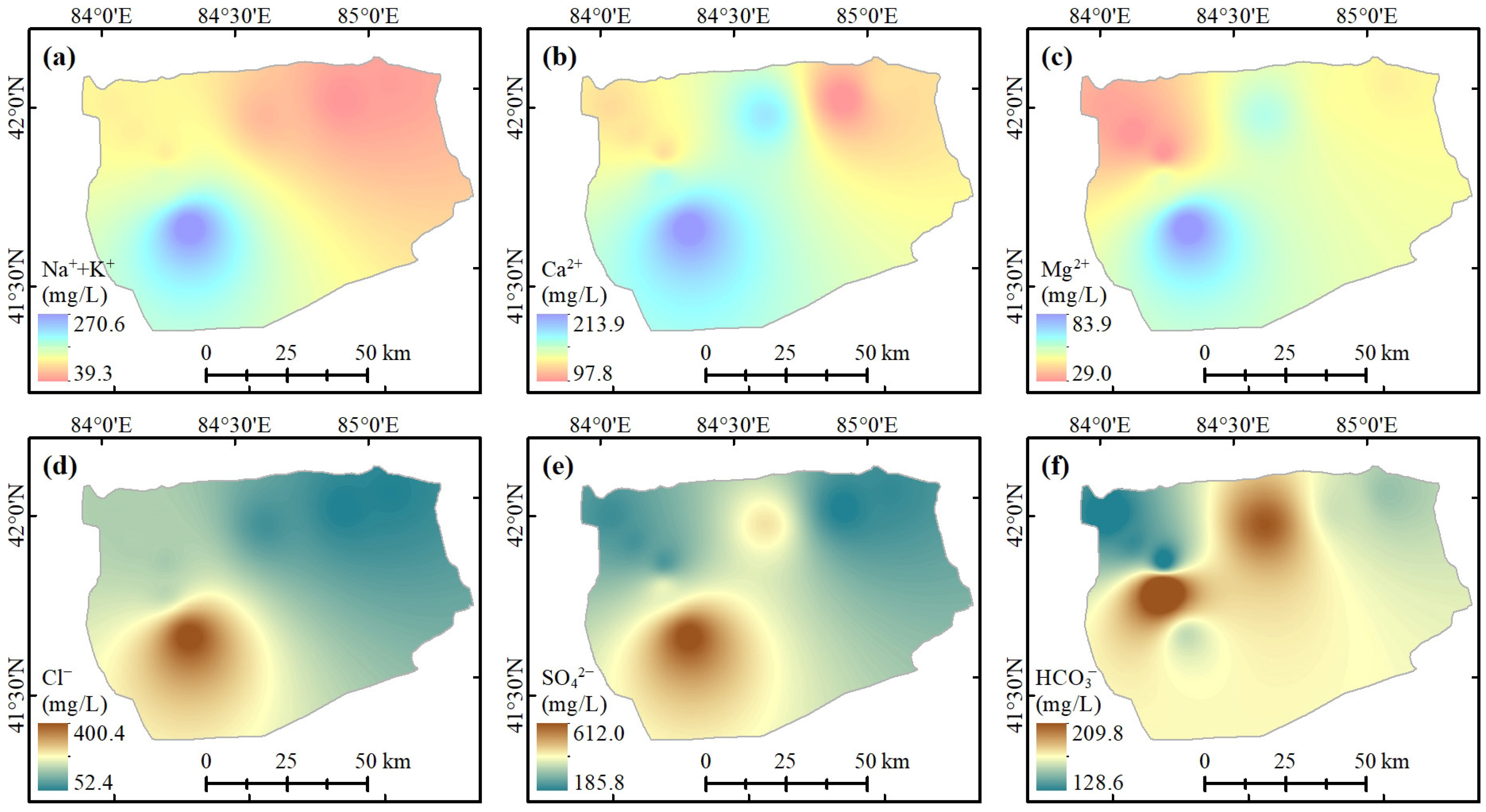
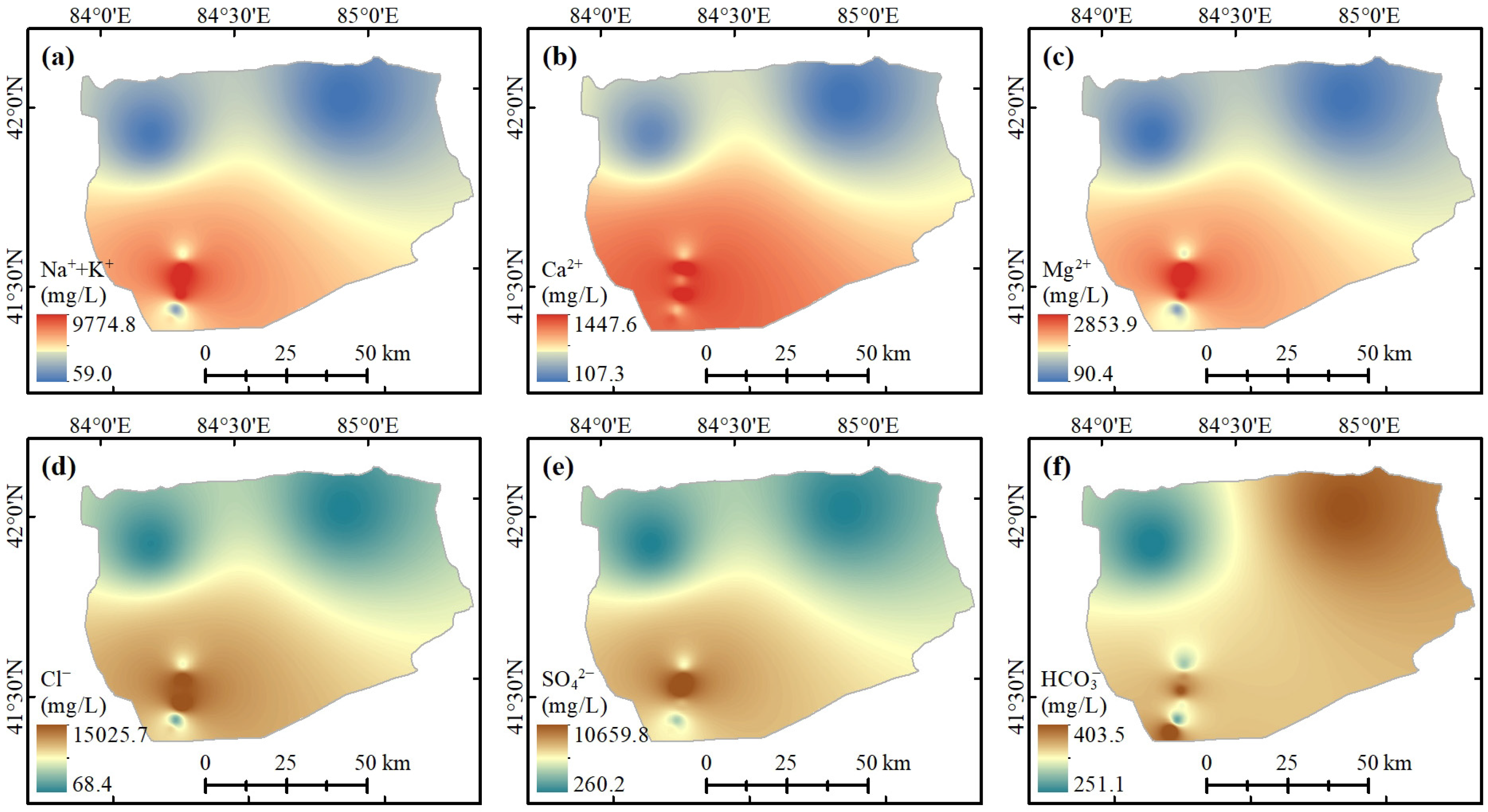
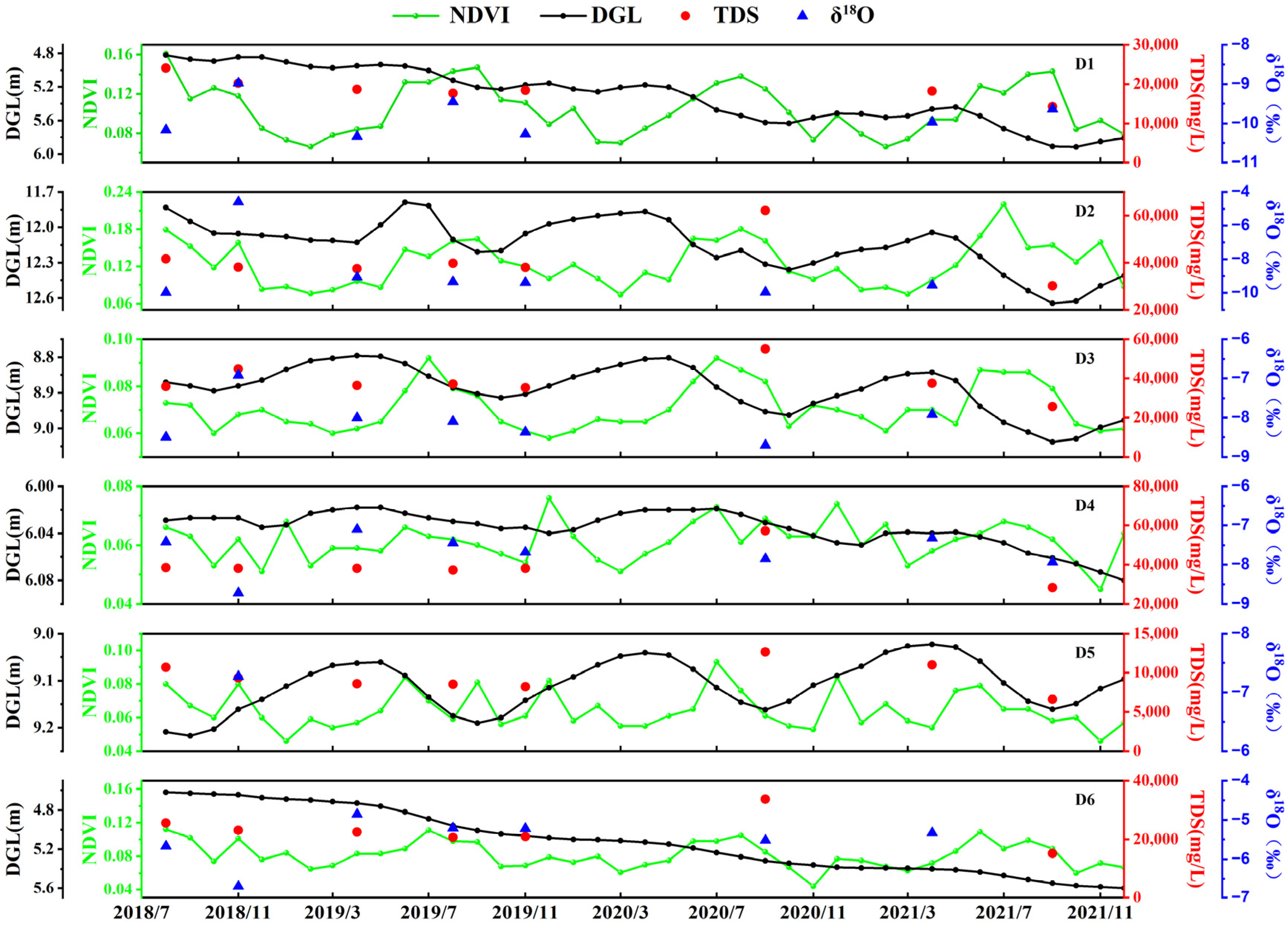
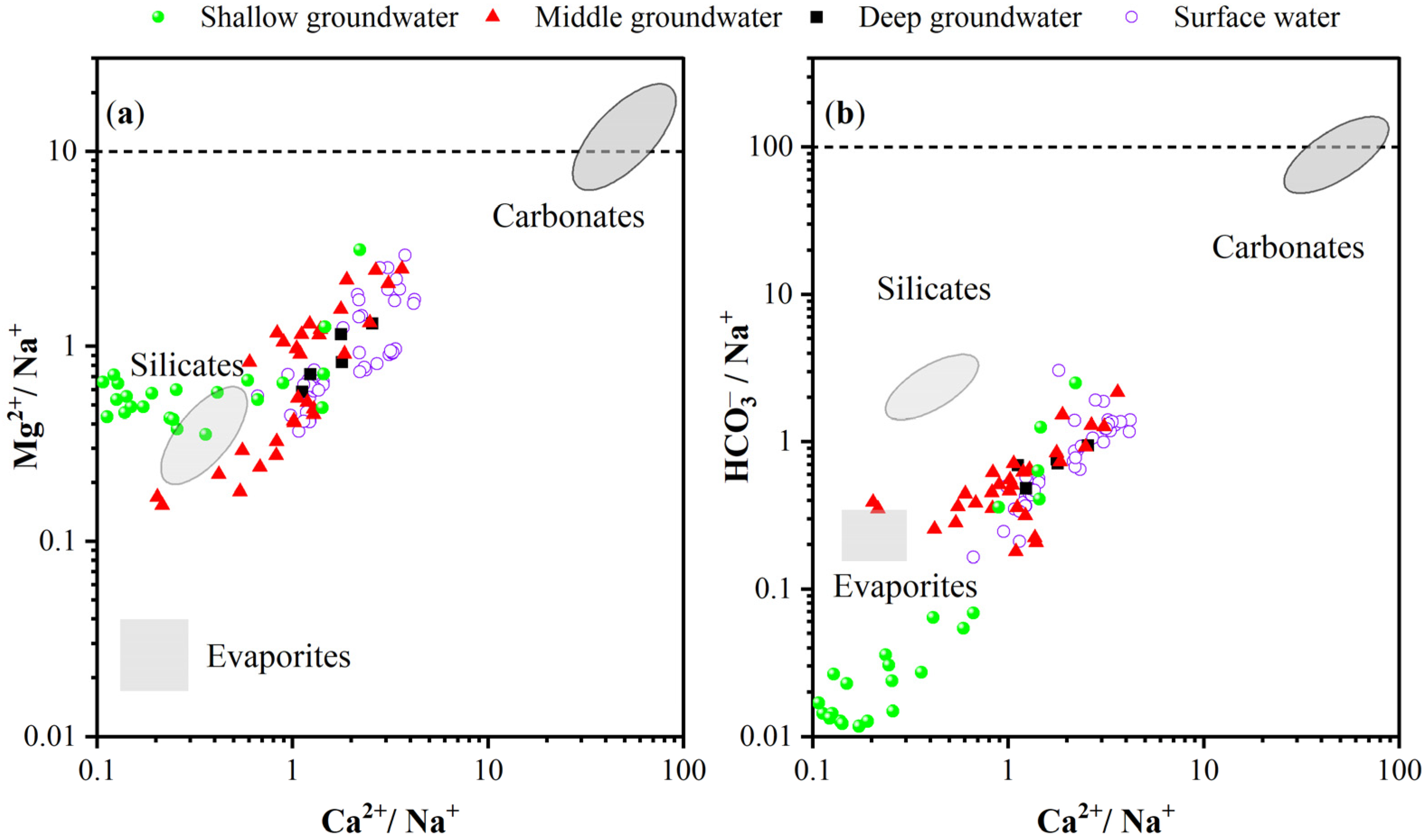
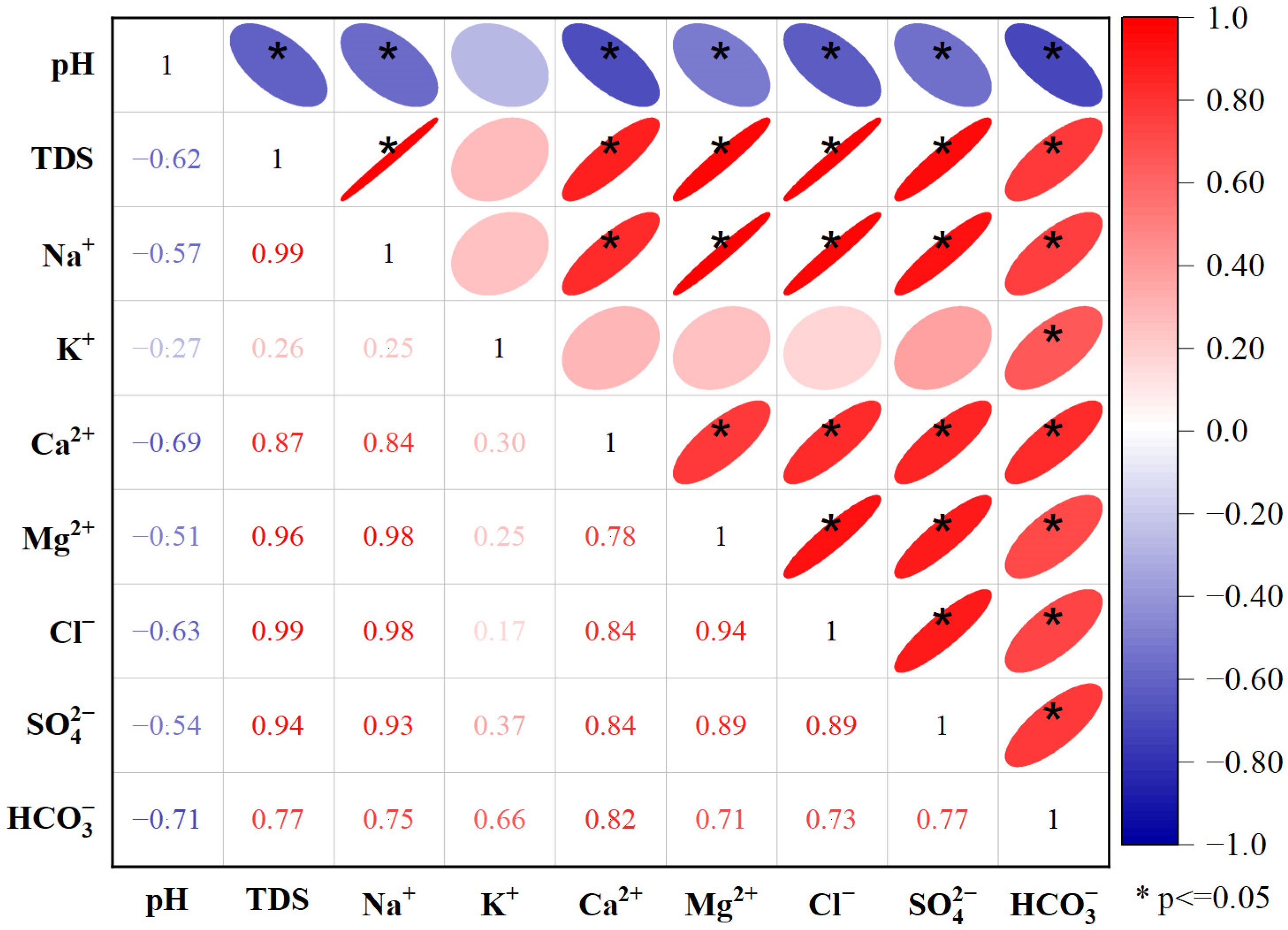
Disclaimer/Publisher’s Note: The statements, opinions and data contained in all publications are solely those of the individual author(s) and contributor(s) and not of MDPI and/or the editor(s). MDPI and/or the editor(s) disclaim responsibility for any injury to people or property resulting from any ideas, methods, instructions or products referred to in the content. |
© 2024 by the authors. Licensee MDPI, Basel, Switzerland. This article is an open access article distributed under the terms and conditions of the Creative Commons Attribution (CC BY) license (https://creativecommons.org/licenses/by/4.0/).
Share and Cite
Yao, Y.; Tu, C.; Hu, G.; Zhang, Y.; Cao, H.; Wang, W.; Wang, W. Groundwater Hydrochemistry and Recharge Process Impacted by Human Activities in an Oasis–Desert in Central Asia. Water 2024, 16, 763. https://doi.org/10.3390/w16050763
Yao Y, Tu C, Hu G, Zhang Y, Cao H, Wang W, Wang W. Groundwater Hydrochemistry and Recharge Process Impacted by Human Activities in an Oasis–Desert in Central Asia. Water. 2024; 16(5):763. https://doi.org/10.3390/w16050763
Chicago/Turabian StyleYao, Yuan, Chenwei Tu, Gaojia Hu, Yuhan Zhang, Hanyuan Cao, Wanrui Wang, and Weihua Wang. 2024. "Groundwater Hydrochemistry and Recharge Process Impacted by Human Activities in an Oasis–Desert in Central Asia" Water 16, no. 5: 763. https://doi.org/10.3390/w16050763





